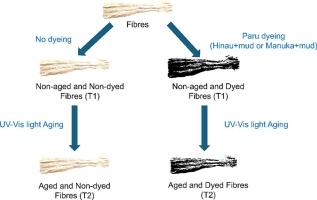Artificially light-aged, black-dyed harakeke fibres: Understanding the correlations between chemical composition and fibre properties using vibrational spectroscopy and chemometrics
IF 4.6
2区 化学
Q1 SPECTROSCOPY
Spectrochimica Acta Part A: Molecular and Biomolecular Spectroscopy
Pub Date : 2025-09-23
DOI:10.1016/j.saa.2025.126960
引用次数: 0
Abstract
The IR and Raman spectra for a series of traditionally black-dyed (with iron-tannate) harakeke (New Zealand flax, Phormium tenax) fibres have been measured. Such fibres are used to make numerous cultural materials by indigenous (Māori) communities in New Zealand. The fibres were subjected to artificial light-aging to determine the changes that occur due to fibre degradation. Fibres could be distinguished using IR spectroscopy based on whether they were dyed, and which form of iron-tannate dye was used, made with either a condensed or hydrolysable tannin (hinau, Elaeocarpus dentatus or manuka, Leptospermum scoparium). Raman spectroscopy differentiated dyed and non-dyed fibres and the type of dye based on the nature of the tannins used. For IR spectroscopy, it was possible to observe spectral changes with aging for the non-dyed and hinau-dyed samples. For non-dyed fibres the aging changes reflected an increase in cellulose crystallinity. For the hinau-dyed samples, the changes appeared to reflect increased oxygen content and higher acidity levels. These are important constituent changes that lead to degradation of fibres.

人工光老化,黑色染色harakeke纤维:利用振动光谱和化学计量学了解化学成分和纤维性能之间的相关性。
测量了一系列传统黑染(鞣酸铁)harakeke(新西兰亚麻,Phormium tenax)纤维的红外光谱和拉曼光谱。这种纤维被新西兰土著(Māori)社区用来制作许多文化材料。对纤维进行人工光老化,以确定由于纤维降解而发生的变化。利用红外光谱可以根据纤维是否染色,以及使用的是哪种形式的铁单宁酸染料来区分纤维,用浓缩或水解单宁(海麻,Elaeocarpus dentatus或manuka, Leptospermum scoparium)制成。拉曼光谱根据所用单宁的性质区分了染色纤维和未染色纤维以及染料的类型。对于红外光谱,可以观察到未染色和染色样品的光谱随老化的变化。对于未染色的纤维,老化变化反映了纤维素结晶度的增加。对于染色的样品,这些变化似乎反映了氧气含量的增加和酸度的提高。这些都是导致纤维降解的重要成分变化。
本文章由计算机程序翻译,如有差异,请以英文原文为准。
求助全文
约1分钟内获得全文
求助全文
来源期刊
CiteScore
8.40
自引率
11.40%
发文量
1364
审稿时长
40 days
期刊介绍:
Spectrochimica Acta, Part A: Molecular and Biomolecular Spectroscopy (SAA) is an interdisciplinary journal which spans from basic to applied aspects of optical spectroscopy in chemistry, medicine, biology, and materials science.
The journal publishes original scientific papers that feature high-quality spectroscopic data and analysis. From the broad range of optical spectroscopies, the emphasis is on electronic, vibrational or rotational spectra of molecules, rather than on spectroscopy based on magnetic moments.
Criteria for publication in SAA are novelty, uniqueness, and outstanding quality. Routine applications of spectroscopic techniques and computational methods are not appropriate.
Topics of particular interest of Spectrochimica Acta Part A include, but are not limited to:
Spectroscopy and dynamics of bioanalytical, biomedical, environmental, and atmospheric sciences,
Novel experimental techniques or instrumentation for molecular spectroscopy,
Novel theoretical and computational methods,
Novel applications in photochemistry and photobiology,
Novel interpretational approaches as well as advances in data analysis based on electronic or vibrational spectroscopy.

 求助内容:
求助内容: 应助结果提醒方式:
应助结果提醒方式:


